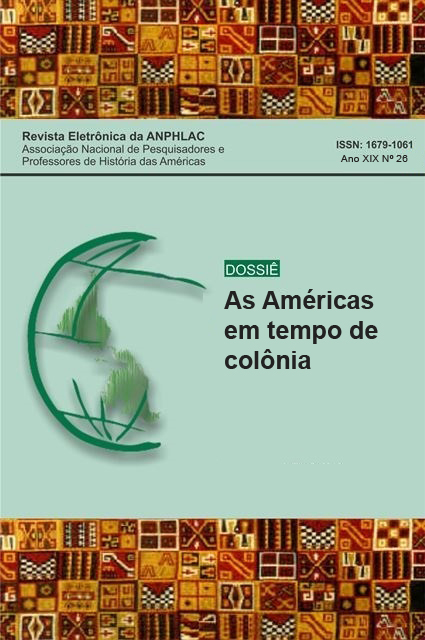Mexica conquests, Castilian conquests: Castilian and native textual structures in the historical section of the Codex Mendoza
DOI:
https://doi.org/10.46752/anphlac.26.2019.3363Resumo
After the conquest of Mexico-Tenochtitlan, the Mexica elites had to rethink their political role in the new society, which included rewriting their histories. One of the first colonial manuscripts containing Mexica histories was the Codex Mendoza, a document produced in 1541 by Mexica upon a request of Viceroy Antonio de Mendoza. The purpose of this article is to analyze the Codex Mendoza’s first section and highlight how the genre of European chronicles was used to structure the alphabetic texts, which are interspersed with the pictorial texts of native origin. It is argued here that the pictorial texts were reduced to illustrations for the Castilian alphabetic texts which, in turn, describe a set of information very similar to what is found in Castilian chronicles. The arrangement of the Codex Mendoza’s history and its Castilian texts demonstrate that native peoples’ pre-Hispanic submission to the Mexica have been projected forward in time, aiming at forming part of the Castilian domains appropriated after the conquest of Mexico-Tenochtitlan and the creation of the Viceroyalty of New Spain.
Keywords: Mexica; codices; chronicle.
Downloads
Referências
Primary Sources
CHARLO BREA, Luis (ed.). Crónica latina de los reyes de Castilla. Cádiz: Universidad de Cádiz, 1984.
FAMSI (Foundation for the Advancement of Mesoamerican Studies, Inc.). Codex Vaticanus 3738 A (Loubat version, 1900 - Universitätsbibliothek Rostock). Available in: < http://www.famsi.org/research/loubat/Vaticanus%203738/thumbs0.html>. Access in February 21st, 2019.
INAH (Instituto Nacional de Antropología e Historia - México). Códice Mendoza. (Images by Bodleian Libraries), 2012. Available in: . Access in June 26th, 2018.
OCAMPO, Florián de. Las cuatro partes enteras de la Crónica de España que mando componer el Serenissimo rey don Alfonso llamado Sabio. Zamora, 1541.
PUYOL, Julio (ed.). Crónica incompleta de los reyes católicos (1469-1476). Según un manuscrito anónimo de la época. Madrid: Academia de la Historia, 1934.
SALAZAR, Pedro de. Coronica de nuestro invictissimo Emperador don Carlos Quinto. Sevilla, 1552.
Secondary Sources
ALCINA FRANCH, José. Códices Mexicanos. Madrid: Editorial MAPFRE, 1992, p. 108-110.
ANDERS, Ferdinand e JANSEN, Maarten. Religión, costumbres e historia de los antiguos mexicanos. Libro explicativo del llamado Códice Vaticano A. (e Facsímile). Espanha: SEQC & Áustria: ADEVA & México: FCE, 1996.
BATALLA ROSADO, Juan José. Matrícula de Tributos y Códice Mendoza: la autoría de un mismo ‘maestro de pintores’ para los folios 6r a 11v del primero y la totalidad del segundo. In: Anales del Museo de América. Vol. 15. La Rioja: Universidad de La Rioja, 2007, p. 9-20. Available in: < https://dialnet.unirioja.es/descarga/articulo/2570721.pdf>. Access in Sept. 15th, 2017.
BERDAN, Frances F. & ANAWALT, Patricia Rielf (ed.). The Codex Mendoza (Vol. 3 - Facsimilar). Berkeley, Los Angeles, Oxford: University of California Press, 1992.
_______. The Essential Codex Mendoza. Los Angeles: University of California Press, 1997.
BROTHERSTON, Gordon. La América indígena en su literatura: los libros del Cuarto Mundo. México: Fondo de Cultura Económica, 1997.
CANCINO, Juan David Figueroa. Conquista-dores e coronistas: as primeiras narrativas sobre o Novo Reino de Granada. PhD Thesis. Brasília: UNB, 2016.
CAÑIZARES-ESGUERRA, Jorge. How to Write the History of the New World: Histories, Epistemologies and Identities in the Eighteenth-Century Atlantic World. Stanford: Stanford University Press, 2001.
CARRASCO, Pedro. Estructura político-territorial del Imperio tenochca. La Triple Alianza de Tenochtitlan, Tetzcoco y Tlacopan. México: El Colegio de México e Fondo de Cultura Económica, 1996, p. 27-30.
DIBBLE, Charles E. Codex Aubin. Historia de la nación mexicana. Reproducción a todo color del Códice de 1576. Colección Chimalistac, v. 16. Madrid: Ediciones José Porrúa Turanzas, 1963.
ESCALANTE GONZALBO, Pablo. Los códices mesoamericanos antes y después de la conquista española. Historia de un lenguaje pictográfico. México: Fondo de Cultura Económica, 2010, p. 61-101.
GLASS, John & ROBERTSON, Donald. A Census of Native Middle American Pictorial Manuscripts. In: WAUCHOPE, Robert (editor). Handbook of Middle American Indians. Vol. 14. Austin: University of Texas Press, 1975, p. 160-161.
KAGAN, Richard L. Clio & the Crown. The Politics of History in Medieval and Early Modern Spain. Baltimore: The Johns Hopkins University Press, 2009.
LEÓN-PORTILLA, Miguel. Literaturas indígenas de México. Madrid: Editorial MAPFRE, 1992.
_______. Códices: os antigos livros do Novo Mundo. (Translation by Carla Carbone – 1st ed. 2003). Florianópolis: Editora da UFSC, 2012.
LOCKHART, James. The Nahuas After the Conquest: A Social and Cultural History of the Indians of Central Mexico (Sixteenth Through Eighteenth Centuries). Stanford: Stanford University Press, 1992.
LÓPEZ AUSTIN, Alfredo & LÓPEZ LUJÁN, Leonardo El pasado indígena. México: Fondo de Cultura Económica, El Colegio de México e Fideicomiso Historia de las Américas, 2001.
MATHES, W. Michael. The America's First Academic Library Santa Cruz de Tlatelolco. Sacramento: California State Library Foundation, 1985.
NAVARRETE LINARES, Federico. Los libros quemados y los nuevos libros. Paradojas de la autenticidad en la tradición mesoamericana. In: DALLAL, Alberto (ed.). La abolición del arte. XXI Coloquio Internacional de Historia del Arte. México: UNAM-IIE, 1998, p. 53-71.
NICHOLSON, H. B. The history of the Codex Mendoza. In: BERDAN, Frances F. & ANAWALT, Patricia Rielf (ed.). The Codex Mendoza (Vol. 1). Berkeley, Los Angeles, Oxford: University of California Press, 1992, p. 1-12.
NOWOTNY, Karl Anton. Tlacuilolli: Style and contents of the mexican pictorial manuscripts with a catalog of the Borgia group. (Translation by George A. Everett and Edward B. Sisson; 1st edition in German, 1961). Norman: University of Oklahoma Press, 2005.
PASTRANA FLORES, Miguel. Códices anotados de tradición náhuatl. In: ROMERO GALVÁN, José Ruben (coord.). Historiografía mexicana: historiografía novohispana de tradición indígena. México: UNAM, 2011, p. 51-84.
QUIÑONES KEBER, Eloise. La representación sobre papel del poder entre los mexicas. In: OLIVIER, Guilhem (Coord.). Símbolos de poder en Mesoamérica. México: UNAM-IIA-IIH, 2008, p. 175-192.
ROBERTSON, Donald. Mexican manuscript painting of the early colonial period. New Haven: Yale University Press, 1959, p. 95-107.
SANTOS, Eduardo N. dos. Tempo, Espaço e Passado na Mesoamérica: o calendário, a cosmografia e a cosmogonia nos códices e textos nahuas. São Paulo: Alameda, 2009.
SIMEÓN, RÉMI. Diccionario de la lengua náhuatl o mexicana. México: Siglo XXI, 1986 (1st. ed. in French, 1885).
UBELAKER, Douglas. "North American Indian Population Size: Changing Perspectives". In: VERANO, John W., UBELAKER, Douglas H. Disease and demography in the Americas. Washington and London: Smithsonian Institution Press, 1992.
Downloads
Publicado
Como Citar
Edição
Seção
Licença
a. Cessão de direitos autorais
Venho, por meio desta, ceder em caráter definitivo os direitos autorais do artigo "____________", de minha autoria, à Revista Eletrônica da ANPHLAC e afirmo estar ciente de que estou sujeito às penalidades da Lei de Direitos Autorais (Nº9609, de 19/02/98) no caso de sua infração. Autorizo a Revista Eletrônica da ANPHLAC a publicar a referida colaboração em meio digital, sem implicância de pagamento de direitosautorais ou taxas aos autores.
b. Declaração de ineditismo e autoria
Atesto que o artigo ora submetido à Revista Eletrônica da ANPHLAC, intitulado "________________________", de minha autoria, nunca foi publicado anteriormente, na íntegra ou em partes, dentro do país. Vindo a ser publicado na Revista Eletrônica da ANPHLAC, comprometo-me a não republicá-lo em qualquer outro veículo editorial.






